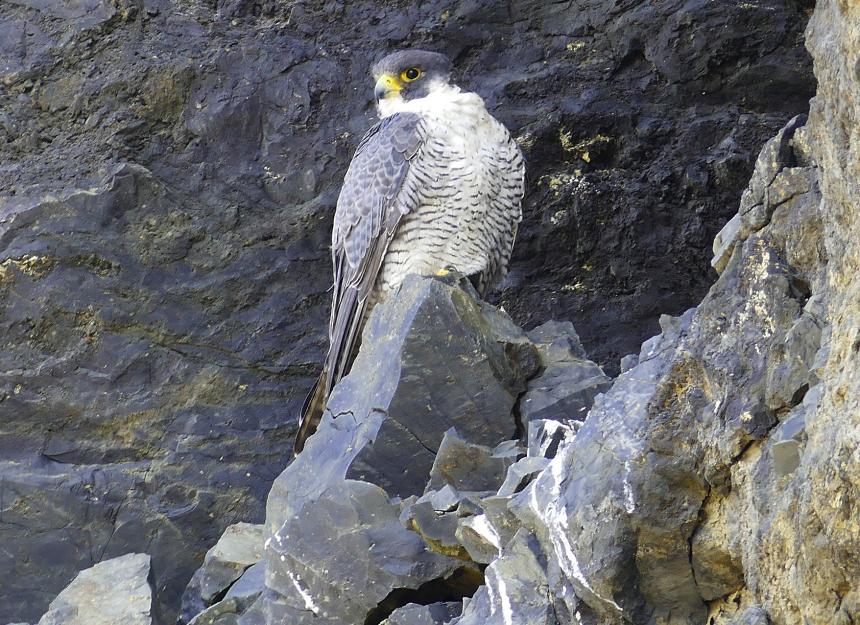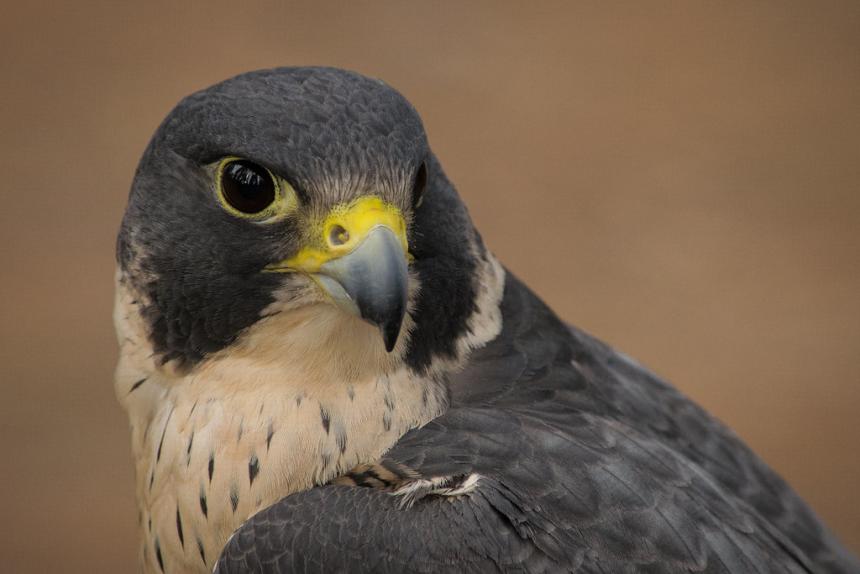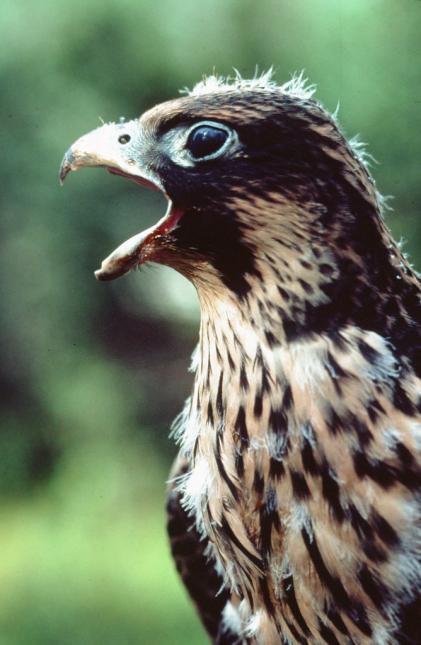Low-
Moderate
Peregrine falcons have experienced a remarkable recovery and the population continues to increase across Washington. The species remains classified as "protected wildlife" under state law (WAC 220-200-100) and continues to be protected under the federal Migratory Bird Treaty Act.
Description and Range
Physical description
Peregrine falcons are 16 to 20 inches in length and have a wingspan ranging from 36 to 44 inches. Adults are dark bluish-black above with a dark cap and wide 'sideburns'; their underside is barred. Adults have yellow coloration around their dark eyes, yellow on the upper part of their beak, and yellow feet. Juveniles are dark brown above and have vertical streaking on their underside.
Ecology and life history
Peregrine falcons usually nest on a cliff near water, but as the species recovers and its range expands, they can also be found nesting on human-built structures, such as tall buildings or bridges, and other locations that offer security and a vantage point above surrounding terrain.
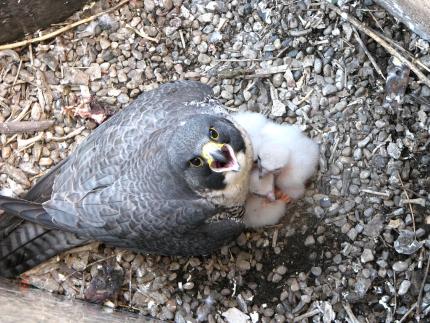
Peregrine falcons are predators of other birds ranging in size up to waterfowl and gulls. They hunt primarily in areas of open cover types that include estuaries, agricultural fields, coastal beaches, water bodies, and in some urban areas.
They are generally monogamous, and may form long term pair bonds.
Geographic range
Peregrine falcons breed up to about 3000 feet in elevation (sometimes higher) in nearly all parts of the state. The highest densities are along the northern outer coast and San Juan Islands. They are also found in Cascade Range foothills, along the Columbia River, and in other water bodies within the Columbia Basin.
This is an uncommon resident, migrant, and wintering species in western lowlands, and a rare to uncommon summer resident and migrant in the mountains and eastern lowlands.
Climate vulnerability
Sensitivity to climate change
Low-
Moderate
Overall sensitivity of peregrine falcons is likely low-mod as this species utilizes a variety of habitat types and forages on a diversity of species. Coastal Peale's peregrine subspecies is highly dependent upon seabird prey; therefore climate change that affects ocean warming and upwelling in coastal areas could affect prey of seabird species (Cassin's auklet and Rhinoceros auklet). Studies in Hudson Bay demonstrate declines in peregrine productivity due to climate change and its affects on increased frequency of heavy rainfall events that lead to increased nestling mortality.
Exposure to climate change
Low-
Moderate
- No specific climate factors identified as it is a generalist. See Sensitivity text>
Regulations
Licenses and permits
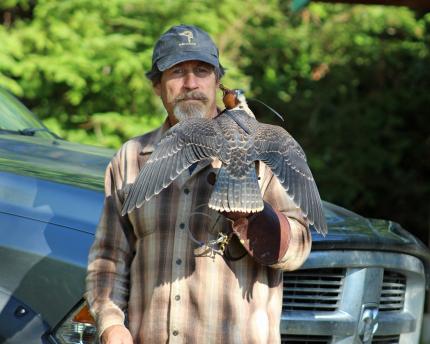
Falconry is the art of training raptors (birds of prey - falcons, eagles, hawks, and owls) to hunt in cooperation with a human and is the sport of actively pursuing wild quarry with those birds. The Washington Department of Fish and Wildlife issues falconry permits, regulates the sport, and remains in contact with the falconry community. No one under any circumstances may keep a raptor as a pet. Only licensed falconers may have birds of prey, and these birds must be flown freely and hunt regularly. State and federal regulations, expertise and dedication of falconers, and self-policing by the falconry community keep the birds in high-quality care. Learn more about the history of this sport and the requirements for falconry in Washington.
Conservation
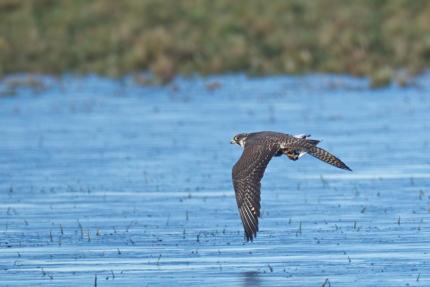
Shortly after the Second World War, peregrine falcons exhibited well-documented population declines across North America and much of their global range following the widespread use of DDT. The falcon was listed nationally as an endangered species by the U.S. Fish and Wildlife Service in 1970 and by the Washington Fish and Wildlife Commission in 1980 when only five pairs were found to be nesting statewide.
With the restriction placed on the use of DDT, the peregrine population has recovered and was removed from the federal endangered species list in 1999. In 2002 the species was reclassified as a state sensitive species after more than 70 territories were found occupied. In 2009, the Washington Department of Fish and Wildlife identified 108 occupied territories, an increase from 91 occupied territories in 2006, and a continued linear increase in the number of occupied territories since 1990. Over 170 breeding territories were documented as of 2014. By 2016, the species' state sensitive status was determined to be no longer applicable under Washington state law.
Resources
References
Anderson, C. M. and S. G. Herman. 2005. Peregrine Falcon (Falco peregrinus). Pp 126-127 in Wahl, T.R., B. Tweit, and S.G. Mlodinow (Eds.), Birds of Washington: status and distribution. Oregon State University, Corvallis, OR, USA. 436 pp.
White, C. M., N. J. Clum, T. J. Cade, and G. Hunt. 2002. Peregrine Falcon (Falco peregrinus). The Birds of North America 660: 1-48.
WDFW publications
PHS Program
Status reports
- Periodic Status Review for the Peregrine Falcon (2024)
- Periodic Status Review for the Peregrine Falcon (2016)
- Washington State Status Report for the Peregrine Falcon (2002)
